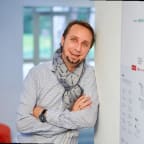TechLead-Story: Thomas Stagl, Director Software Development at Dynatrace

Thomas Stagl
Team
How big is your Dev-Team? Into what functional sub-teams is it divided?
We are a team of 1,000 people working in engineering, representing a third of the organization (all in all, Dynatrace is approximately 3,000 employees strong). The heart of our Dev team beats in Europe. Many of us are located in Austria, where Dynatrace was founded. We are organized in over 100 teams in 8 engineering locations, or R&D labs, as we call our fabulous offices. Five labs are in Austria: in Linz, Hagenberg, Klagenfurt, Graz and in Vienna. The other three are in Barcelona, Gdansk, and Detroit. Our lab locations represent some of the most livable cities, which is a huge plus imho 😊. Overall, we are a very international, colorful community of people contributing to one single, market-leading product: The Dynatrace Software intelligence platform.
I’m located in Vienna, where three teams are delivering the Dynatrace Software Intelligence Hub. The Hub enables our customers to leverage out-of-the-box integrations from an extensive array of over 500 technologies, and to create custom Dynatrace integrations. This allows digital teams to easily extend Dynatrace’s automation and AI-assistance across more environments and use cases.
How is your development team organized and what reasons led you to organize in that particular way? What are the advantages and disadvantages?
With Dynatrace, it's all about the value we deliver to ourselves and to our customers. The basic ingredient for this is minimum red tape and maximum autonomy. This means each team is fully self-managed and works closely together with the Product Owner and Product Management to deliver value. The teams are either using SCRUM or Kanban to organize their work. As a whole organization, we are working in a highly agile and fully technology-focused environment where everyone speaks the same language. This implies that each team is organized fully cross-functional. All required roles are based within the teams to deliver software of extraordinary quality. That includes product owners, front-end, back-end, and team captains. For additional support the teams can have architects, quality coaches, and security experts join them on request.
We run our software development cycle on an extremely high level of automation, making it tremendously easy for teams to push their changes from concept to production at light speed. We know that teams reach their best performance when they have a chance to work with clear boundaries and interfaces and can decide as autonomously as possible how to reach their goals. Therefore, we have defined a clear autonomy principle that guides each person in our organization through autonomous decision-making.
What makes your team – in comparison with other teams – special?
Our teams do not just execute what someone tells them to do. Everyone contributes with their own ideas and thrives with autonomy and responsibility. It’s this unique combination that makes our team special: We are passionate about delivering the best software product in the world, and very professional about quality and scalability, with a very high level of automation in our software development life cycle. But we are also very humble, supportive, and open-minded, eager to continue to learn. We know that every new Dynatracer brings something unique to the team that helps us grow and innovate. This combination creates an atmosphere where continuous learning and growth are in everybody’s DNA.
As a company, we live an agile, entrepreneurial culture at heart, where everyone has an impact. Mix that with the fact that we are the global market leader in software intelligence and a publicly traded, growing multimillion-dollar company, delivering the essential ingredient for the digital transformation of the world’s largest organizations, and you get a pretty unique combination. And not to forget: Our R&D labs are based in some of the most livable locations in the world. This combination makes us unique and special. You won’t find any other company like Dynatrace around.
Recruiting
How is your development department integrated into your recruiting process?
The team is strongly involved in the recruiting process. This is important for us and for the candidates. In first-round interviews you usually meet Development Directors. Obviously, our aim is to get to know each other, and to find a common understanding about a potential fit for both, the candidate and Dynatrace.
In second rounds, the team comes into play even more: usually the team captain joins the interview, and we focus on more detailed technical aspects. We usually ask candidates to prepare a task for the second round. This practical task is designed by the team and represents a topic, one would be working on in the future.
Is there a set procedure for new hires? How are they integrated?
Starting a new job is always exciting. This is why we offer a R&D-wide Onboarding Journey for everyone, with the goal to provide as much information as possible, so nothing stands in the way of having a smooth start at Dynatrace. The Onboarding Journey includes various general sessions and specialized, Dev-focused sessions. Plus: you get to meet lots of supportive people, that you can turn to in case any questions arise. We asked some of our colleagues about their onboarding experience, so if you’re interested, you can check it out here: YouTube.
What do you look for in addition to technical qualifications when you are looking for a new developer?
As we are a tech-company inside out, you probably expect that technology skills are very important. This is obviously the case. But besides that, we also know that a strong culture is one of the key success factors of an organization. That is why we look for people who would strive in the environment we have at Dynatrace: Passionate and creative minds with a strong willingness to learn, grow, and adapt, and to solve not yet solved complex problems by pushing boundaries. If you are even detail-oriented, or if you can work with some level of flexibility or ambiguity and still drive results you will enjoy working at Dynatrace.
Technologies
What technical challenges are you facing?
One of the biggest challenges we face are scalability and complexity, as we find ourselves on a continuous growth path. To power digital services, organizations are shifting from traditional on-premises data centers to multicloud environments with Kubernetes as the orchestration layer. These environments are dynamic, with applications, microservices, containers, and infrastructure coming and going in seconds, and a volume, velocity, and variety of data that’s beyond human capacity to manage. As we cooperate with the giants of the digital world, we are not only required to process data on a massive scale but also to think about scalability, starting from UX (e.g. how to display 50.000 hosts on one page) down to the level of processing these amounts of data.
Which technologies do you work with?
You name it! We design and build intelligent software by using state-of-the-art technologies. Besides, we are also researching next-generation software solutions, and contributing to the open-source community. Our tech stack includes Java, Python, Angular, React.js, TypeScript, Kubernetes, Docker, Keptn, Cloud, Jenkins, Jira, Bitbucket, Selenium and Spark - just to name a few.
How have the technologies you use changed since your founding?
In a nutshell: Dynatrace was founded 2005 in Linz/Austria. It all started with dynamic tracing - hence the name 😉. Since the beginning, we were aiming high. The goal was not to develop small-scale solutions but to work on a product for the global market right from the start. With the right goals in mind, constant reinvention, and a product at the pulse of customer needs, we grew fast and attracted great attention on international markets. We anticipated the shift to dynamic multiclouds and the massive increase of complexity and re-invented our Software Intelligence Platform. At heart, we always kept the same company led by the same visionary management team. Today, with integrated AIOps and Cloud Automation at the core of our platform, Dynatrace provides software intelligence covering the full range of BizDevSecOps use cases. Dynatrace is an all-in-one-platform that shatters silos and aligns digital teams for efficiency and speed. And we do not stand still. If you join us, you can expect to contribute to the next reinvention of Dynatrace already.
Dev Interview Info
































